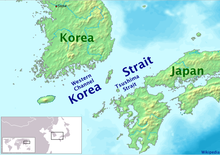
Back Straat van Korea Afrikaans كوريا (مضيق) Arabic Estrechu de Corea AST Koreya boğazı Azerbaijani Корея боғаҙы Bashkir Selat Koréa BAN Карэйскі праліў Byelorussian Корейски проток Bulgarian কোরিয়া প্রণালী Bengali/Bangla Strizh-mor Korea Breton
34°35′58″N 129°47′48″E / 34.59944°N 129.79667°E
| Korea Strait | |
|---|---|
 Map showing the Korea Strait. | |
| Japanese name | |
| Kanji | 対馬海峡/朝鮮海峡 |
| Hiragana | つしまかいきょう/ちょうせんかいきょう |
| Revised Hepburn | Tsushima Kaikyō /Chōsen kaikyō |
| South Korean name | |
| Hangul | 대한해협 |
| Hanja | 大韓海峽 |
| Revised Romanization | Daehan Haehyeop |
| North Korean name | |
| Chosŏn'gŭl | 조선해협 |
| Hancha | 朝鮮海峽 |
| McCune–Reischauer | Chosŏn Haehyŏp |
The Korea Strait is a sea passage in East Asia between the Korean Peninsula and Japan. It connects the East China Sea, the Yellow Sea and the Sea of Japan in the northwest Pacific Ocean. The strait is split by Tsushima Island into two parts: the Western Channel, and the Tsushima Strait or Eastern Channel. It is economically important, as many shipping lanes pass through the strait, and both Japan and South Korea allow free passage through it.
In ancient times, both Buddhism and Mongol invaders passed over the strait to reach Japan. More recently, it was the site of the 1950 Battle of Korea Strait during the Korean War. A tunnel running underneath the strait connecting Japan and Korea, the Japan–Korea Undersea Tunnel, has been proposed to connect the two countries.